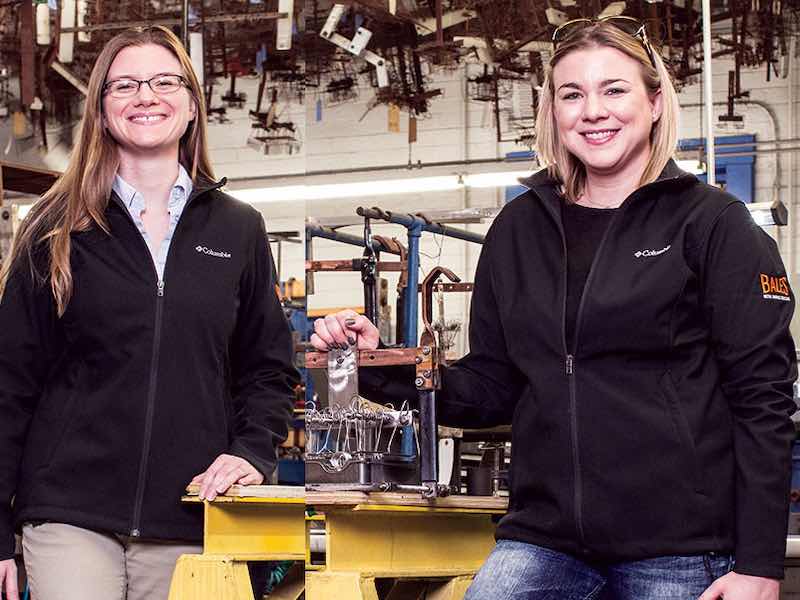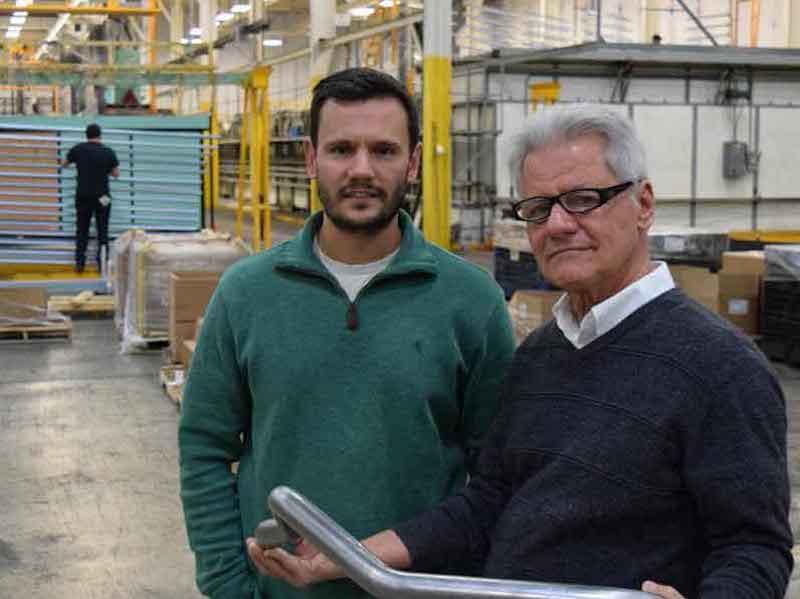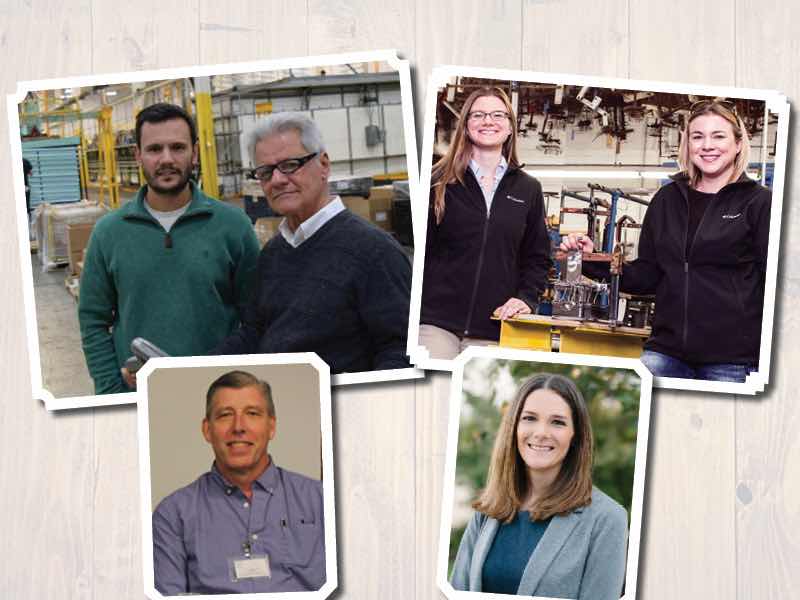Like most small business owners, finishing and coating operators have a tendency to want to pass along their company to the next generation of family members.
In fact, statistics show that upwards of 70% of small business owners prefer to have their children or other family members take over the operation, but yet only 15% ever truly accomplish that, according to Eido Walny, founder of the Walny Legal Group in Milwaukee.
“The key to understanding that massive disconnect is in the lack of business succession planning,” Walny tells PNC Insights. “Business succession can’t be founded on a wish. Handing over keys one morning is not a plan. There is a lot that needs to be thought through, and the facts bear out that very few business owners give enough thought to succession planning.”
The HR firm Co-Advantage found that “58% of small business owners do not have a succession plan to govern what the company will do when they retire or face some other’ transition event.’”
At the recent Chicago Midwest Chapter of the NASF annual conference, several shops and suppliers took part in a panel discussion moderated by www.FinishingAndCoating.com that discussed past, present, and future succession planning.
Bales Metal Surface Solutions President Stacey Bales, Accent Metal Finishing President Doug Mangino, Haviland Enterprises President Meg Post, and Gatto Industrial Platers Chairman George Gatto Sr. all discussed the succession processes they went through over the past several years.
Bales and her sister, Sara, took over their company when their father suddenly passed away without a succession plan or a will. Mangino purchased his company after contentious negotiations with the former owner. Post was recruited to Haviland four years ago as a vice president and has risen to become president and CEO. Gatto Sr. passed the company along to his son and daughter after he decided to step away from day-to-day operations.
Here is a synopsis of the panel discussion at the Chicago NASF meeting:
Transition Overview
Stacey Bales, Bales Metal Surface Solutions
 Sara and Stacey BalesI started working for the company when I was 12 years old because my dad and uncle owned the business, and that’s just what you do. So I started off cleaning the offices, and that transitioned to helping my aunt with filing, which transitioned to working in our masking department. I helped out in shipping and receiving and in sales; I worked my way up to office manager right about the same time that we opened a second location in Texas in 2001. My uncle had retired at that point and had moved across the country, and my dad was flying down to our Texas operations about a week or so out of every month. Fast forward to 2009. My dad was in Texas and just didn’t come to work one day; we found out that he had passed away at 53 years old.
Sara and Stacey BalesI started working for the company when I was 12 years old because my dad and uncle owned the business, and that’s just what you do. So I started off cleaning the offices, and that transitioned to helping my aunt with filing, which transitioned to working in our masking department. I helped out in shipping and receiving and in sales; I worked my way up to office manager right about the same time that we opened a second location in Texas in 2001. My uncle had retired at that point and had moved across the country, and my dad was flying down to our Texas operations about a week or so out of every month. Fast forward to 2009. My dad was in Texas and just didn’t come to work one day; we found out that he had passed away at 53 years old.
So at 27 years old, I found myself owning an electroplating company with my younger 25-year-old sister, Sara, and it was just us. There was no transition; there was no talk of succession planning. At 53 years old, who thinks that something like that is going to happen?
Keep in mind we were right at the tail end of the recession in 2009, and we had just put a substantial addition to our building. When the bank learned our dad had passed —two days before Thanksgiving— the bank called us in to sit down. When they walked in, they didn’t say ‘sorry’ or ‘we heard about your dad’ — nothing of the sort; their question was, “How are we going to liquidate?” That just set the fire burning.
Sara and I winged a lot of our transition; we are very fortunate that we have a lot of long-time loyal employees. We inherited some family members that worked there, and it was a difficult transition; nobody knew who was supposed to be at the top of the food chain, so there was a lot of tension around positions, responsibilities, and some trust issues.
To this day, neither my sister nor I can jump on any one of our plating lines and plate a part; we don’t have that in our wheelhouse. I’ve taken the CEF courses, and I retained about 50% of it, so we rely heavily on our team. I’m good at accounting, I’m good at business, and that’s my focus. I rely heavily on our experienced team to manage the day-to-day operations.
George Gatto Sr., Gatto Industrial Platers
 George Gatto Jr. and George Gatto Sr.Our company was started by Jimmy Wessendorf, who was my brother’s father-in-law. My dad was the accountant, my brother was involved in trucking, and I was the plant manager.
George Gatto Jr. and George Gatto Sr.Our company was started by Jimmy Wessendorf, who was my brother’s father-in-law. My dad was the accountant, my brother was involved in trucking, and I was the plant manager.
My dad and I stayed together as a partner; my dad ran the office, and I was more of a visionary. When we bought the company, we paid $225,000 for it. A mentor came in named Harry Clark and kind of taught me the business. We were doing about $350,000 when we bought the company, and there were about 18 employees. Today we’re doing $20 million, and we have 150 employees, so we grew it.
I got the company up to about $15 million, and my long-time goal was $20 million in sales; George Jr. is the one that got us that that part up to there. He came on board, and he worked when he was a kid for one year for us, and he was racking parts. I said to him the next year, “are you going to come again this year,” and he said, “Dad, I was thinking I’m going to buy a grass cutter.” He said, “I think in one day I could make as much as I did all week working for you.”
But I was very impressed with the way he did that. He went to college he became a commercial real estate broker; he was doing okay at that, but then times got tough in 2008 and 2009, and I talked to him I said, “Son, now’s the time; I got about five years left, and I’m going to get out of this business. I’m in the real estate business, too, so I was going to either sell it, quit, liquidate it, or do something.”
George Jr. came on board. I didn’t want to start him in the lab or in maintenance and all that baloney; I wanted him to run the business because he ran the grass-cutting business pretty well. I knew he had it; he had the ability to get the team moving in the same direction. I told the employees you’re going to have a new boss.
Meg Post, Haviland Enterprises
 Meg PostI have a finance degree from Grand Valley State University in Grand Rapids, MI, and I started my career in the financial consulting world. I was working for a business valuation advisory firm, working with middle-market businesses to determine what their business was worth for succession planning, M&A advisory, and other purposes. I also worked with employee-owned companies — or ESOP companies, who are required by the Department of Labor to have a valuation done annually.
Meg PostI have a finance degree from Grand Valley State University in Grand Rapids, MI, and I started my career in the financial consulting world. I was working for a business valuation advisory firm, working with middle-market businesses to determine what their business was worth for succession planning, M&A advisory, and other purposes. I also worked with employee-owned companies — or ESOP companies, who are required by the Department of Labor to have a valuation done annually.
I was valuing companies in a variety of industries, different size ranges all across the country. Haviland is a 100% ESOP-owned company, and I was doing their annual stock valuation. The company’s long-time CFO was retiring in 2018, and I ended up choosing to transition to a corporate role and began as VP of Finance in 2018 and was promoted to CFO in 2020.
This past fall, I was promoted to president and, in July, to president and CEO. It’s been a quick transition from being in pure finance and consulting role over to the corporate side and now to running the business. I’ve really enjoyed the transition and the challenges of the new role, and I’m excited for what’s to come at Haviland.
Doug Mangino, Accent Metal Finishing
 Doug ManginoIt was a storm show in 100 ways. I own and run Accent Metal Finishing, and we’ve been around since 1979; we’re small with 10 employees. In 1997, I was working for Hubbard-Hall, and I took a sales territory out here in Chicago. The first guy I went to see was the prior owner at Accent, and I walked into a problem with the phosphate line; I mean, literally, he’s like, “We got to go out on the line and fix this,” and I was in tech service for a while I never knew you guys had problems and all of a sudden we had problems. Turns out he wasn’t happy with the transition from me to the next the last sales rep to me. We spent two or three later evenings there figuring it out, and about six months later, he said, “You might want to come work with me and maybe think about buying the place.” I’m like, “Screw you; I mean, you dropped me like a hot potato, and now I’m going come work at this Podunk little company in the middle of nowhere. No.”
Doug ManginoIt was a storm show in 100 ways. I own and run Accent Metal Finishing, and we’ve been around since 1979; we’re small with 10 employees. In 1997, I was working for Hubbard-Hall, and I took a sales territory out here in Chicago. The first guy I went to see was the prior owner at Accent, and I walked into a problem with the phosphate line; I mean, literally, he’s like, “We got to go out on the line and fix this,” and I was in tech service for a while I never knew you guys had problems and all of a sudden we had problems. Turns out he wasn’t happy with the transition from me to the next the last sales rep to me. We spent two or three later evenings there figuring it out, and about six months later, he said, “You might want to come work with me and maybe think about buying the place.” I’m like, “Screw you; I mean, you dropped me like a hot potato, and now I’m going come work at this Podunk little company in the middle of nowhere. No.”
He called me every six months, and a year or two later, I said, “maybe I’ll give it a chance. The plan was to start in 2000 and work for four or five years, he retired, and then I bought the place, which is what we were doing. He retired a little earlier, and we started talking about the buyout, and it went absolutely crazy sideways. It just did not go smoothly. I’ve said it a thousand times: I don’t know how to buy a company, but I know how not to buy a company, so if you ever want to know what not to do, I’m your guy
He never sold a company, and I never bought one, so you kind of go into it thinking you have to dot all the I’s and cross all the T’s, but you don’t have to overthink every little detail. It got personal between us, and there was a slide. It just got to be we were friends, but we couldn’t be friends at that point. It has to be you’re the buyer, or you’re the seller
Make sure your buyer’s level of commitment, and as a buyer, make sure your seller’s level of commitment. He wanted to sell the company, but when the rubber hit the road, it got to be “I built this up from nothing, and now I’m passing along to you,” and I candidly said, “You picked me. I didn’t come knocking on your door to try and buy the place,” and it just got way too emotional to the point where we had a blow-up once on the phone, and he’s like “I don’t know you anymore.” I told my wife, and she said, “Buy the place, quit, just run it for him, or get out.” I don’t think she meant to get out permanently, but “get your stuff together.”
What Went Right in the Transition Process
Stacey Bales, Bales Metal Surface Solutions
Luckily for us, our dad was a blue-collar, all-hands-on-deck kind of guy. He was raised by a single mom and was one of four kids. He had a job when he was 10 and worked his whole life. He started Bales when he was 18 in my uncle’s garage; it’s like the true American dream starting out with nothing, and you work hard and grow something amazing. We watched him go to work on Saturdays and Sundays, and he would put plating lines together by himself; he was welding things together and doing all kinds of crazy stuff, so inheriting our dad’s work ethic was the number one thing that went right in our transition process.
Number two is that he was completely transparent with every facet of the business; even at 27 years old, I had already been privy to meetings with accountants and lawyers, business professionals, and financial planners. I knew everybody I needed to when it all hit the fan, and they all knew me. So transparency and just a good work ethic.
Meg Post, Haviland Enterprises
I’ll speak about two different transitions that the company’s gone through. The first is the transition from family ownership to 100% ESOP ownership; that was big, and it happened before my time. They established the ESOP back in 1997 and then went the full 100 percent transaction in 2012. They had planned well in advance of starting that ownership transition, so I’d say what went right in that sense was the company planned ahead.
The ownership transition is complete, and the company’s facilities, employees, and culture are still intact. If we had been bought out by somebody else — by private equity or a competitor — the company would likely look very different today. We maintained the company’s legacy, and I’d say that was a success.
From my more personal transition into this role, I’d say what my predecessor Mike did right for me was that he was willing to say, “I’m done, and I’m turning this over, and I’m going to exit.” He could have tried to maintain control in various ways, and I’m very grateful for his guidance in the past and his willingness to let go and make a full transition.
Doug Mangino, Accent Metal Finishing
We got the deal done, and that’s really what it all boiled down to. It sounds really negative; it just happened to be a rough go of it. Ultimately, the positive was I learned more about how to run a company — and how to own a company — through all the tumult we had; and there was a lot. It was never about money or anything like that; it was always about I was taking something from him that he offered, and he just seemed uncomfortable.
We had our issues with the bank because he didn’t want to participate in the financing of it, and banks were going to make him subordinate so the bank would get their money first. He felt as though he didn’t have to do that because I should be able to figure out a way to borrow all the money in the world, and it was all the money in the world to me at that point. I learned more about the real world and business. I wasn’t stupid about it prior to that, but I didn’t realize it until I was there.
And there’s so much other stuff going on that you didn’t have time to think about it so much. In retrospect, I think I probably just learned more about how to run a company, and I’m probably better for it. I probably run a better business now than I would have if it went very smoothly, which is silly, but that’s the way it works.
George Gatto Sr., Gatto Industrial Platers
George Jr. was raised by my wife, and she did a good job. Some kids fall victim to their parent’s success, but he was hungry to be a success on his own. George has a work ethic; when he came on board, he knew exactly how this was going to work. As far as getting the team on his side, he slowly became the boss, and everybody accepted him.
On Setting Up a Current Transition Plan
Stacey Bales, Bales Metal Surface Solutions
No, we haven’t established a succession plan, which goes against everything that we have learned! I am going to be 40 this year, so I still feel pretty young. I have a 22-year-old daughter who is in nursing school, so it doesn’t seem like she’s going to come on board. My sister has a daughter who is 15 and still in high school, so it’s a little too early to tell what her future holds.
I have joked for a long time that starting my career at our company so young — and after being through the things we have — that I have a 5-year retirement plan that looks like finding a new president to oversee the day-to-day operations and slowly stepping away.
Doug Mangino, Accent Metal Finishing
In my head, I have a couple of ideas, but I don’t have an exit strategy. When I was buying the place, my attorney said, “What’s your exit strategy?” and I told them it was “To enter” because I was just trying to buy the place. I have one daughter, and she has no desire, so I don’t think that’s really a possibility. Maybe she will get married someday, and whoever she marries might want to take it over; that’s an option. Nobody at my shop is really interested, and frankly even capable. They don’t have the level of commitment to do it that I might have had or still have. I’ve got a couple of things rattling around in my head. Anybody who wants to buy it will give you my card, but you got to wait a few years because I’m not quite old enough to get out.
We bought in 2008, and that was the best year we’ve ever had, and then the worst year we’ve ever had was 2009. I’m talking about a 37% drop. I went home one day, and my wife said, “How much did it cost us this month?” because it was costing us money. Not only was I not paying myself, but I was also squeaking enough money to pay my loan and contribute money from home. But we made a ton the year before, so after two years, I was net zero, but I wasn’t negative, so that was okay. But she’d say to me, “Why again did we buy this place?” I didn’t have a good answer, but 2009 didn’t kill us. Your highest debt load on day one — and every year after that — it’s no different than buying a house; once you’ve been there for 15 years, it doesn’t feel that bad. If things get tight, you don’t really have a great plan in place, but I got a few things in my head.
On Employees Adapting to Different Managerial Styles
Meg Post, Haviland Enterprises
It’s not night and day different, but we are different people from different generations, so there are definitely differences. I think no matter what transition you’re in — just from one person to the next — there’s always going to be adjustments that the employees are making and that the team is making.
They’re going to have to react to a different type of person who makes decisions differently and has different expectations. So even if you have two very similar people back-to-back, employees are still going to be adjusting.
Doug Mangino, Accent Metal Finishing
The previous retired in 2004, and I bought the company in 2008, so I was running it from 2004 on. But I didn’t own it, and they knew he was still in the picture. I was the go-to for those four years, plus I’d known everyone in the shop for the four years prior and more. Things ran through me at that point, so the transition from me being out in the shop once in a while to being in the office was super smooth.
Additionally, with our customer base when we transitioned, by the time I bought it, no one even remembered the previous owner. He was not the key man, which actually made it a lot easier for me. That was one of the positives.
Stacey Bales, Bales Metal Surface Solutions
Our dad had been traveling to Texas about a week or two out of every month, so I was accustomed to making decisions in his absence.
I’m a little more methodical about things and rely more on data, whereas my dad was able to visualize the plan in his head. I also rely on our team’s input, and we collaborate more today to achieve results.
When is the Best Time to Implement a Transition Plan?
Meg Post, Haviland Enterprises
If you’re the owner of the business looking at when and how to exit, you start a lot earlier than you think you have to. Transitioning ownership and transitioning your role as president or CEO are two very different things, and you have to look at them separately.
Doug Mangino, Accent Metal Finishing
Now would be a good time for me. I could continue owning it, and they could run it, sell it to someone, or have them do a buy-in somehow.
I’m not ready to get out yet because I feel like at 56, maybe another five to eight years. But I’d like to be done by then. If I find someone today and I’m not ready to get out, no one’s going to wait around.
Lessons Learned in the Transition
Stacey Bales, Bales Metal Surface Solutions
If you’re a business owner and your succession plan is your family, you should have those conversations early on.
Even if you think you’re too young, it’s good to let people know what your plan is. Putting your plan on paper would be even better, but transparency is everything in a family-owned business.
George Gatto Sr., Gatto Industrial Platers
Picking the right person to transition is important. You could be the smartest guy in the room, but you got to have the ability to get the team moving in the same direction.
A lot of people make mistakes because they promote people that are very smart, but they just don’t know how to deal with people. And that’s one of the things with my son; I’m very proud to say that he has the ability to lead and so that’s very important.
Doug Mangino, Accent Metal Finishing
I would say go into it with eyes wide open. Pick the right person; hopefully, it’s the right person, but be as transparent as you can be about what you’re looking to get out of it. Once you establish a number — and we had a number early on that didn’t matter — at some point, it was the minutia that goes along with it, so make sure if you’re the buyer to make sure the seller at least you get as much information as you can.
And then share as much as you can, or if you’re on the other side of the same thing, you have got to ask all the questions. The crap that comes up if you don’t have those at the 11th hour; all that does is create undue strain. I almost walked away from it personally, even though I’d invested all that time. It didn’t matter at that point. But I’m going to be an easy seller. Just give me the right color credit card.



































